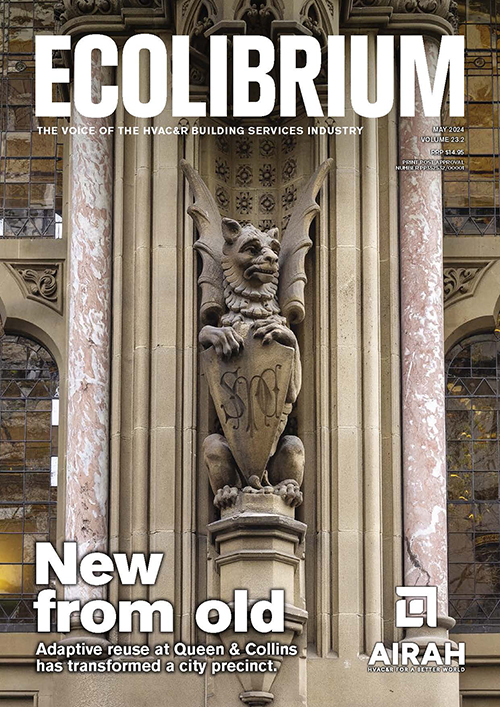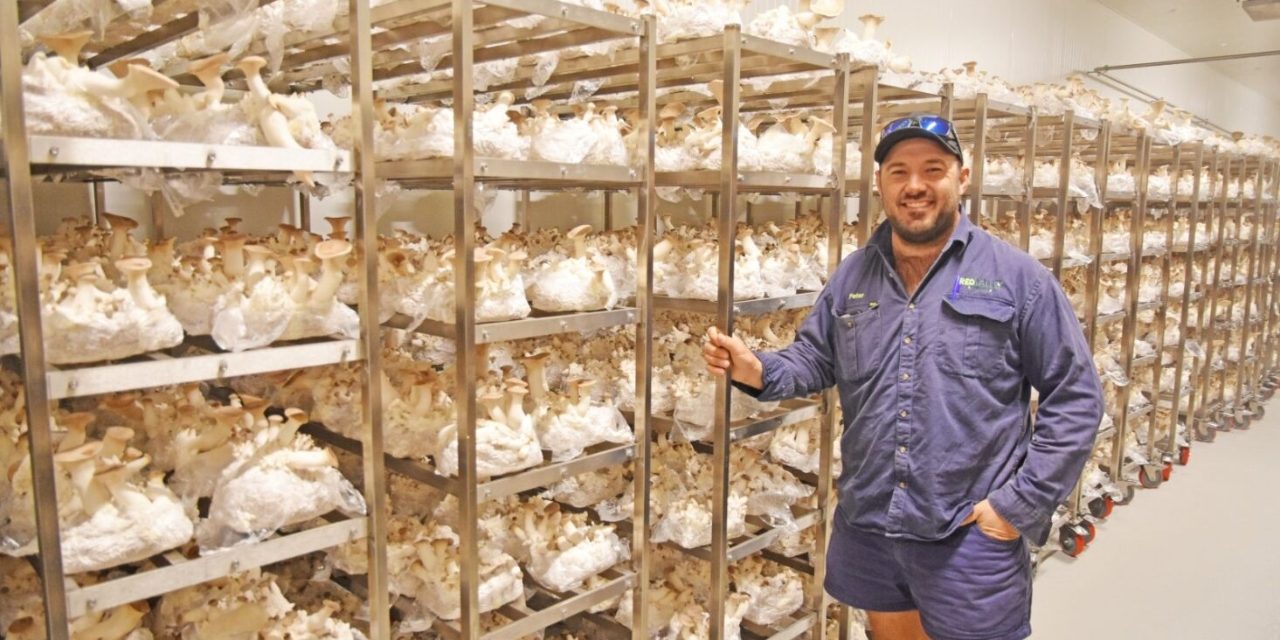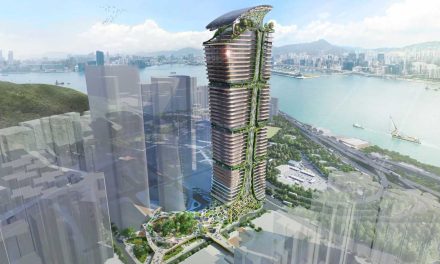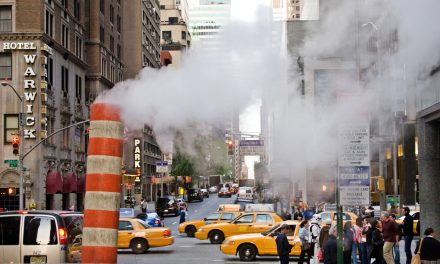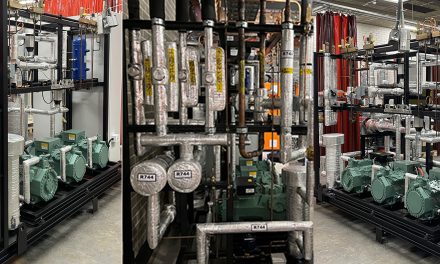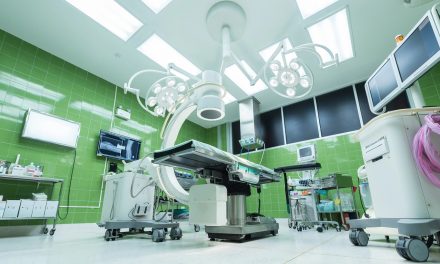On a remote farm in Far North Queensland, a family business overcame adversity to realise a “green dream” in the design of a 8,500m² mushroom production facility. Sean McGowan reports.
The Inderbitzins are a proud family who have been on the land for three generations. And they are still working hard to ensure their passion for farming can be enjoyed by generations to come.
After arriving in Australia from Switzerland in 1972, the Inderbitzins were determined to make a life for themselves in the dairy farming industry. But that soon changed as the family discovered the Lakeland region, three hours north of Cairns in Far North Queensland.
The rich red soil, big blocks and flat plains led them to experiment with a range of crops before establishing the first banana plantation in Lakeland.
Since then, Red Valley Farms has continued to grow, with the family’s third generation taking over the reins.
Later, during a holiday visiting family in Switzerland, the Inderbitzins were shown an award-winning exotic mushroom facility in Kerns. Kerner Edelpilze uses substrate based on Swiss wood and cultivated in-house to produce premium organic produce in a zero-carbon facility.
Recognising that the sustainability ethos aligned with that of their Red Valley Farms mission, the Inderbitzins began to dream of building a similar facility.
They also saw the potential to diversify away from bananas while utilising their own existing organic compost as the base for a high-quality substrate.
That journey towards mushroom farming began when the family approached Cairns-based consulting engineering firm SEQUAL Mechanical for the HVAC design.
SEQUAL was given the opportunity to tour the Swiss facility with the Inderbitzins and see firsthand the high benchmark before starting a preliminary design.
This led SEQUAL to seek interest from several reputable mechanical services contractors for early contractor involvement (ECI).
However, that selection process was not completed because the Inderbitzins elected to pursue a design and construct (D&C) solution directly with a mechanical services contractor, without further involvement from SEQUAL.
“The Red Valley project is an example of how HVAC and industrial engineers can benefit from working together”
Back to the future
Fast-forward 18 months and Cairns-based builder Keir QLD was in its final stages of entering into a contract to construct the new facility at Red Valley Farms, when the electrical team identified a major issue with the site electrical infrastructure.
The D&C mechanical services contractor’s design had comprised an air-cooled chilled water plant with a coefficient of performance (COP) of 2.01, which would significantly exceed the site electrical infrastructure and associated design allowances.
Additionally, it would consume an enormous volume of diesel annually when the off-grid generator was used.
With the family’s ambitions for the project in serious jeopardy, Keir sought assistance from SEQUAL to completely redesign the HVAC services and save the project.
“Following a detailed interrogation of Red Valley Farm’s site-specific performance requirements and incorporation of various air-side energy-recovery initiatives, we redesigned the air distribution arrangement,” says Sonia Holzheimer, M.AIRAH, Principal Mechanical Engineer at SEQUAL.
Understanding that the viability of the project hinged on the attainment of exceptional COP, Holzheimer then sought out the collaboration and expertise of Stefan Jensen, F.AIRAH, Managing Director at Scantec Refrigeration Technologies.
“I actually approached Scantec twice for this project,” Holzheimer says.
“The first time was when issuing an expression of interest (EOI) for early contractor involvement. I was aware that Scantec had recently supplied and installed a low-charge NH3 refrigerating plant for another farm on the Atherton Tablelands near Cairns.”
At that time, Holzheimer says Jensen had been particularly persuasive in highlighting the superior energy efficiency offered by low-charge NH3 central energy plant.
“It was obvious that this was potentially an excellent application for a central refrigerating plant reticulating a secondary refrigerant such as water or a weak solution of propylene glycol and water,” says Jensen.
At that time, the HFC phase-down had already commenced, making ammonia (a natural refrigerant) a more attractive choice for primary refrigerant.
But it was the need to focus on energy efficiency that ultimately led to Holzheimer returning to Scantec and their NH3 solution.
“Such systems are very common in the food and beverage industries in Australia, but less so in mechanical services,” says Jensen.
“The Red Valley project is an example of how HVAC and industrial engineers can benefit from working together as opposed to maintaining the traditional demarcation lines between disciplines.”
“Not only was the ammonia refrigerating plant able to deliver the lowest power and energy consumption values, but it was also the most attractive commercially”
Breaking the mould
To get the project back on track, the primary task facing Holzheimer and the SEQUAL team was to ensure the energy consumption of the HVAC systems was as low as possible.
Unlike other crops, mushrooms respirate to produce CO2. The bulk of the facility’s design heat load therefore originates from the cooling and dehumidification of the fresh air supplied into the facility to displace the CO2 accumulating in the production spaces.
SEQUAL began a complete redesign of the system, and achieved a reduction in the main air-handling duties by as much as 45 per cent.
Air movement within each chamber and around the shelves storing product was also a consideration. Air movement must be correctly regulated to ensure optimum growing conditions.
The Inderbitzins were also specific in wanting to avoid the use of fabric duct for the fresh air supply. Accordingly, SEQUAL had to develop an effective fresh air supply arrangement that would avoid creating a condensation problem either at the fresh air entry to the chamber, or within the chamber itself.
On top of all that, the virulence of mushroom spores required significant thought. To protect the hygiene of the substrate both during and post creation, and to prevent mushroom spore species from contaminating adjacent chambers, hospital infection control principles were applied, as well as laboratory physical containment and pressure differential measures throughout.
To this end, the interior of the facility has much in common with a PC laboratory and includes clean rooms, physical containment chambers, directional air movement and pressure differentials as necessary for all stages of mushroom production.
“It must be noted that these technical challenges were identified and resolved in the absence of a design guideline or briefing document,” Holzheimer says.
Rather, she relied on recollections of the tour of Kernser Edelpilze and a drawing layout of various rooms within that vast facility with a range of environmental requirements (temperature, humidity and CO2) nominated for each room at strict tolerance and with individual control.
Low charge
Before SEQUAL’s involvement, the previous HVAC design had comprised an air-cooled chilled water plant using R134a with poor COP (3.59 NPLV and peak load 2.01) and significant power supply requirements exceeding the available capacity of the site’s electrical infrastructure.
To improve COP and achieve further reductions in central energy plant power requirements, the air-cooled plant was abandoned in lieu of a water-cooled NH3 solution. This required the expansion of a site water treatment facility to provide the necessary cooling water make-up.
But the Inderbitzins could see what the technology offered both in the short and long term. They were won over by the superior thermodynamic performance of NH3, and the established efficiency and longevity of ammonia refrigeration systems, including local “runs on the board” at nearby farms.
“Not only was the ammonia refrigerating plant able to deliver the lowest power and energy consumption values,” says Jensen, “but it was also the most attractive commercially.”
Notwithstanding the benefits of NH3, the remote location of Red Valley Farms posed challenges for design and construction.
“As a Cairns-based consultancy, we are often engaged for projects in remote or very remote locations,” says Holzheimer. “Due to the lack of local technical support, or freight and logistical limitations, in most cases the response generally preferred by clients and end-users is to simplify the solution.
“Of course, the energy-efficiency needs of the Red Valley project demanded a significantly more sophisticated and centralised solution.”
“Of course, the energy–efficiency needs of the Red Valley project demanded a significantly more sophisticated and centralised solution”
Secondary fluid
The air conditioning and ventilation systems is highly sophisticated. It maintains individual, close-controlled environmental conditions within individual production and maturing rooms, with year-round challenging ambient conditions, at benchmark system seasonal energy efficiency ratio (SEER).
The plant comprises three refrigerating compressors operating in parallel.
These operate at 81 per cent of maximum permissible rotational speeds at peak ambient design conditions of 38˚C and 50%RH. Should one compressor fail, the rotational speed of the remaining two compressors will accelerate to maximum speeds and provide 84 per cent redundancy.
The plant comprises two evaporative condensers for redundancy, and are manufactured from 304 stainless steel for longevity.
All ammonia refrigerant is confined to the plantroom. Field refrigeration requirements are serviced by a reticulated secondary refrigerant comprising a solution of 15 per cent by weight propylene glycol and water suitable for “habitable” areas.
This chilled glycol is provided by two glycol/NH3 semi-welded cassette heat exchangers (PHEs) operating in parallel. In the interest of redundancy, even when only one PHE is operational, the system can provide 75–85 per cent of the design cooling capacity.
This secondary refrigerant solution, reticulated around the facility via three recirculation pumps, has a freezing point of approximately -5˚C.
The system design permits operation of the plant down to secondary refrigerant temperatures of around -1˚C to -2˚C, and lower at reduced overall heat loads. These reduced glycol temperatures enable greater dehumidification, as well as a temporary reduction in production room temperatures. They will also allow for the future integration of coldrooms.
With a design secondary refrigerant temperature of 1.5˚C, all coolers and air handling units (AHUs) have been selected for a secondary refrigerant temperature of 2.0˚C to provide for a design margin and an allowance for glycol temperature gain between the plant area and the most remote air cooler/heat exchanger.
Bespoke air coolers serving production rooms have been manufactured in Germany from 316 stainless steel, including all tube/fin heat exchangers, casings and drip trays.
Two independent fresh air handling units (AHUs) supply 9 and 7m3/s of preconditioned fresh air to the production and sub-maturing spaces respectively. Both are designed for peak ambient inlet air conditions of 38.0˚C/29˚C (dry/wet bulb) temperature and an outlet dry bulb temperature of <10˚C.
Airflow throughout the facility is strictly managed, designed and balanced to provide directional airflow from clean to less-clean areas. This ensures containment and prevents contamination of virulent mushroom spores from one chamber to another.
Importantly, pre-conditioned fresh air is ionised (cleaned) using a dedicated system prior to introduction to each room to remove all odours, thereby preventing the mushrooms from taking on any undesirable flavours during production.
Each room is provided with an air supply and exhaust damper. When CO2 levels rise above a set-point, the supply damper gradually opens for fresh air supply in concert with the exhaust damper. Once the CO2 level approaches the set-point, the dampers gradually close.
“The Red Valley project is an example of how HVAC and industrial engineers can benefit from working together as opposed to maintaining the traditional demarcation lines between disciplines”
We are the champignons
Scantec’s installation and commissioning crews from Brisbane were relocated onsite for the duration of the construction period. For electrical works, Scantec partnered with a small Cairns-based refrigeration and electrical company.
“Not only was this practical from an installation and service point of view, but it benefits the Red Valley Farm business that there is a service company locally that is deeply familiar with all the control and monitoring elements that are crucial for the product quality,” says Jensen.
Additionally, Jensen says that the company has acquired a degree of knowledge regarding mechanical maintenance of the NH3 plan, and that level of knowledge will grow as the plant ages and more maintenance tasks are taken over by Red Valley Farm staff or local contractors.
Practical completion of the Red Valley Mushrooms facility was reached in mid-2022, with the facility having been successfully served by the low charge NH3 central energy plant as mushroom production has ramped up.
A year on, Red Valley is reported to be Australia’s largest exotic mushroom farm, with the Inderbitzins initially growing two types of mushrooms – King Oyster and standard Oyster.
The farm has since added Shimeji and Shiitake varieties, and when at full scale is expected to employ up to 45 people.
In the short term, the low charge NH3 central energy plant and associated HVAC system design were vital for the project to proceed. In the long term, the benefits of the sustainable approach to the design will benefit Red Valley Farms for many years to come.
In keeping with this ethos, the family plans on taking the facility off the grid in coming years, exploring options including solar, batteries and potentially hydrogen.
Like to know more?
SEQUAL was finalist in 2023 Excellence in Sustainability category for its work on the Red Valley Mushrooms facility.
Tropics and the wet bulb
Designing energy-efficient refrigeration and HVAC systems in the tropics is no mean feat, with a design wet bulb temperature of around 29˚C driving up the design condensing temperature and the design heat loads.
According to Stefan Jensen, F.AIRAH, Managing Director at Scantec Refrigeration Technologies in the case of the Red Valley Mushrooms project, a significant proportion of the heat load is associated with conditioning of fresh air that is supplied to the facility to displace the CO2 emitted during growing.
“During the cooler months, however, when ambient conditions are relatively pleasant and indeed popular with people camping in the area, the head loads reduce to a fraction of the design capacity,” says Jensen.
“This places special demands on the turn-down ratio of the refrigerating plant. The use of several speed-controlled reciprocating compressors operating in parallel delivers superior part-load energy efficiency compared with all other compressor types and compressor sequencing methods.”
